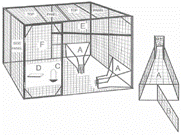Eastern Wildlife Damage Control Conferences
Date of this Version
10-1-1997
Document Type
Article
Abstract
The private industry involvement in nuisance animal damage control is increasing in Kansas. Improved oversight of that industry is needed and the Kansas Department of Wildlife and Parks (KDWP) plans to implement a mandatory education and certification program beginning in 1998. KDWP currently issues permits to individuals who wish to trap or control nuisance animals outside of normal harvest seasons. Individuals who have held these permits to conduct nuisance animal damage control were surveyed in 1995 to better understand the status and needs of that industry in Kansas. A 3-page mail survey was sent to all 93 permit holders. Raccoons (Procyon lotor), beaver (Castor Canadensis), and skunks (Mephitis mephitis) were the species most often involved in complaints. Most damage control was conducted from March to June and occurred in both urban and rural areas. About 42% of the individuals doing nuisance animal damage control work did not receive monetary compensation for their services. Most respondents believed there was competition for control services from KDWP, Cooperative Extension Service, and the USDA-Animal and Plant Health Inspection Service-Animal Damage Control program. There was strong support for a mandatory training and certification program. About half of all respondents indicated there is potential or strong potential for new private nuisance animal damage control businesses. Private animal damage control appears to have a future in Kansas. That future should include continuing cooperation and coordination between public natural resource management agencies and private damage control operators.



Comments
Published in Proceedings of the Eighth Eastern Wildlife Damage Management Conference, Roanoke, Virginia, October 16–19, 1997, edited by James A. Parkhurst. Copyright © 1997 by the authors.